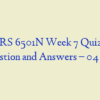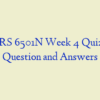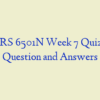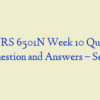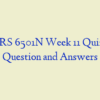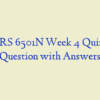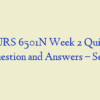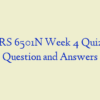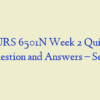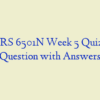Description
NURS 6501N Week 2 Quiz with Answers (40 out of 40)
- A 4-month-old female is diagnosed with atopic dermatitis (AD). Which of the following assessment findings by the nurse will most likely support this diagnosis?
- Researchers now believe that RA is:
- A 42-year-old female presents with raised red lesions with a brownish scale. She was diagnosed with discoid lupus erythematosus. A clinician recalls this disorder is related to:
- A 70-year-old female presents with a hip fracture. She is diagnosed with osteoporosis. One factor that most likely contributed to her condition is:
- The nurse would be correct in identifying the duration of rubella as:
- A 20-year-old female presents with vaginal itch and thin-walled pustular lesions. She is diagnosed with candidiasis. This condition is caused by a:
- A 4-month-old male is brought to his primary care provider for severe itching and skin lesions. He is diagnosed with atopic dermatitis. Which of the following would be elevated in this patient?
- A 4-month-old female develops white spots and shallow ulcers in her mouth. Her pediatrician diagnoses her with thrush. This condition is caused by:
- Which of the following people is at highest risk for the development of gout?
- Rubella, rubeola, and roseola are common communicable diseases caused by _____ infection.
- A 3-year-old male develops tinea capitis after playing with the family dog. This infection is caused by a:
- The final stage of gout, characterized by crystalline deposits in cartilage, synovial membranes, and soft tissue, is called:
- A 70-year-old female presents with a hip fracture secondary to osteoporosis. This condition is caused by an increase in bone:
- The pathophysiology student would correctly identify the etiologic agent of smallpox as:
- A 30-year-old female complains of fatigue, arthritis, rash, and changes in urine color. Laboratory testing reveals anemia, lymphopenia, and kidney inflammation. Assuming a diagnosis of SLE, which of the following is also likely to be present?
- A 35-year-old male is diagnosed with lobar pneumonia (lung infection). Which of the following exudates would be present in the highest concentration at the site of this advanced inflammatory response?
- Exhaustion occurs if the stress continues and _____ is not successful.
- A 30-year-old male was diagnosed with HIV. Which of the following treatments would be most effective?
- A 30-year-old female is diagnosed with cancer. Testing reveals that the cancer cells have spread to local lymph nodes. A nurse realizes this cancer would be documented as stage:
- A patient has a disease state that results from the secretion of toxins by bacteria. Which medical diagnosis will the nurse see documented on the chart?
- When histamine is released in the body, which of the following responses would the nurse expect? nurs 6501n week 2
- When the maternal immune system becomes sensitized against antigens expressed by the fetus, what type of immune reaction occurs?
- A 20-year-old male shoots his hand with a nail gun while replacing roofing shingles. Which of the following cell types would be the first to aid in killing bacteria to prevent infection in his hand?
- A 35-year-old male is diagnosed with a hormone-secreting tumor of the adrenal medulla. He experiences elevated blood pressure, pupil dilation, “goose bumps,” and increased anxiety. Which of the following hormones is the predominant one released by the tumor? nurs 6501n week 2
- Which of the following individuals would be at greatest risk for an opportunistic infection?
- After teaching about stress, which information indicates a correct understanding of stress?
- An 8-year-old female presents with edema of the cutaneous and mucosal tissue layers. Her mother reports that the condition is recurrent and seems to occur more often during stressful situations. The child is diagnosed with hereditary angioedema. Which of the following is deficient in this child?
- During inflammation, the liver is stimulated to release plasma proteins, collectively known as:
- Which of the following hormones activates adrenergic receptors?
- A child fell off the swing and scraped the right knee. The injured area becomes painful. What else will the nurse observe upon assessment?
- An infant develops a fever secondary to a bacterial infection. Which of the following most likely triggered the fever?
- Stress induces sympathetic stimulation of the adrenal medulla. This causes the secretion of catecholamines, which include:
- A patient presents with poison ivy on the extremities, face, and buttocks. This condition is an example of:
- While planning care, a nurse recalls seasonal allergic rhinitis is expressed through:
- A 65-year-old female is diagnosed with metastatic breast cancer. She has developed muscle wasting. Which of the following substances would be produced in large quantities to eliminate the tumor cells and cause muscle wasting?
- A 30-year-old female presents to her primary care provider reporting fatigue, excessive sweating, and increased appetite. Physical examination reveals protruding eyes, and laboratory testing reveals hyperthyroidism secondary to autoantibody production. This disorder falls into the category of type _____ hypersensitivity.
- While planning care for children with cancer, which information should the nurse remember? Most childhood cancers originate from the:
- A 30-year-old male is having difficulty breathing and has been spitting blood. He reports that he began experiencing this reaction after cleaning his pigeons’ cages. Testing reveals he is suffering from allergic alveolitis. Which of the following is he experiencing? nurs 6501n week 2
- Which patient will develop active immunity? A patient who:
- A 10-year-old male is stung by a bee while playing in the yard. He begins itching and develops pain, swelling, redness, and respiratory difficulties. He is suffering from:


